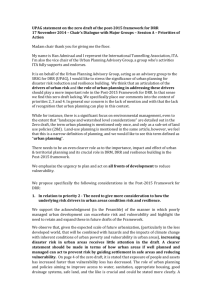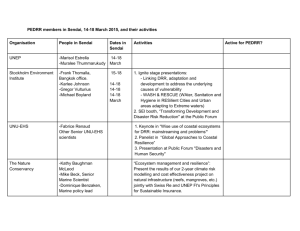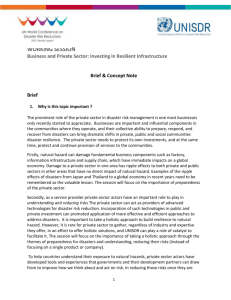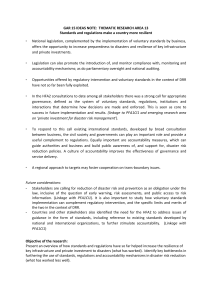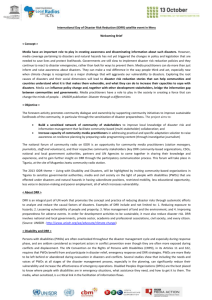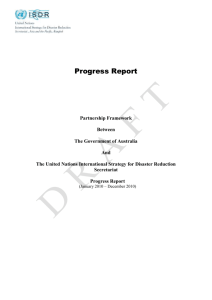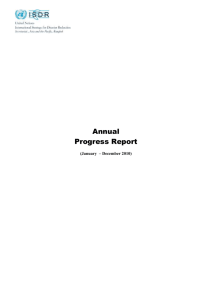View concept note
advertisement
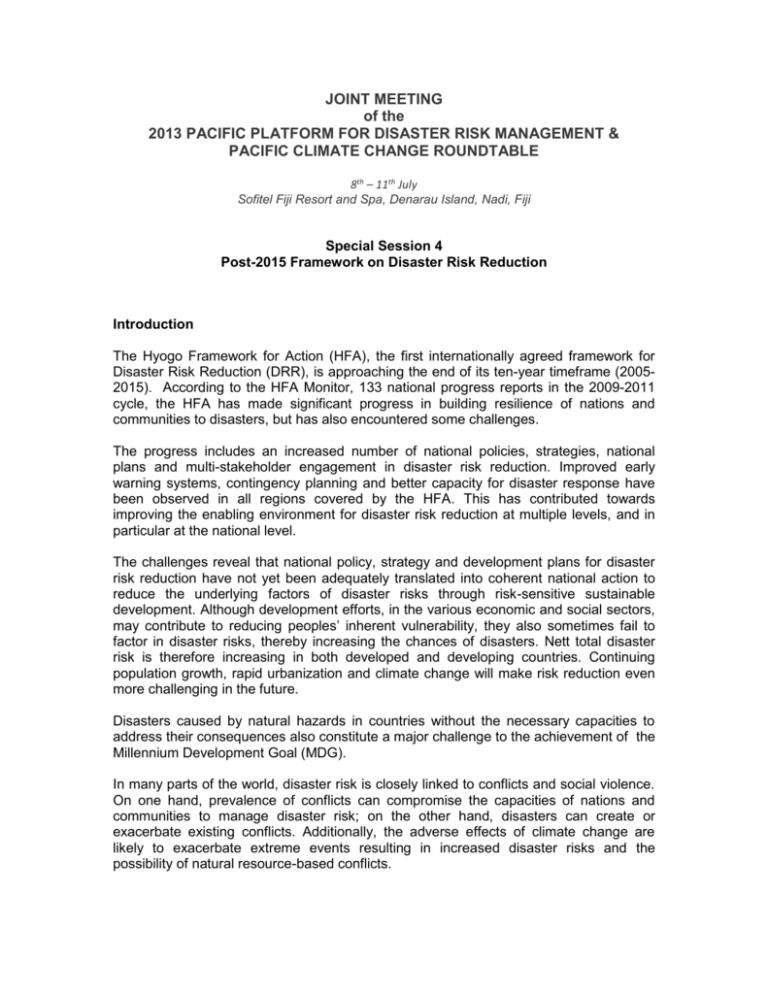
JOINT MEETING of the 2013 PACIFIC PLATFORM FOR DISASTER RISK MANAGEMENT & PACIFIC CLIMATE CHANGE ROUNDTABLE 8th – 11th July Sofitel Fiji Resort and Spa, Denarau Island, Nadi, Fiji Special Session 4 Post-2015 Framework on Disaster Risk Reduction Introduction The Hyogo Framework for Action (HFA), the first internationally agreed framework for Disaster Risk Reduction (DRR), is approaching the end of its ten-year timeframe (20052015). According to the HFA Monitor, 133 national progress reports in the 2009-2011 cycle, the HFA has made significant progress in building resilience of nations and communities to disasters, but has also encountered some challenges. The progress includes an increased number of national policies, strategies, national plans and multi-stakeholder engagement in disaster risk reduction. Improved early warning systems, contingency planning and better capacity for disaster response have been observed in all regions covered by the HFA. This has contributed towards improving the enabling environment for disaster risk reduction at multiple levels, and in particular at the national level. The challenges reveal that national policy, strategy and development plans for disaster risk reduction have not yet been adequately translated into coherent national action to reduce the underlying factors of disaster risks through risk-sensitive sustainable development. Although development efforts, in the various economic and social sectors, may contribute to reducing peoples’ inherent vulnerability, they also sometimes fail to factor in disaster risks, thereby increasing the chances of disasters. Nett total disaster risk is therefore increasing in both developed and developing countries. Continuing population growth, rapid urbanization and climate change will make risk reduction even more challenging in the future. Disasters caused by natural hazards in countries without the necessary capacities to address their consequences also constitute a major challenge to the achievement of the Millennium Development Goal (MDG). In many parts of the world, disaster risk is closely linked to conflicts and social violence. On one hand, prevalence of conflicts can compromise the capacities of nations and communities to manage disaster risk; on the other hand, disasters can create or exacerbate existing conflicts. Additionally, the adverse effects of climate change are likely to exacerbate extreme events resulting in increased disaster risks and the possibility of natural resource-based conflicts. Furthermore, many developing countries experience both disasters and social conflicts. The interaction between the two creates and perpetuates vulnerabilities that place communities at risk, forming a major obstacle to sustainable development. To reverse the current risk trend and re-energize commitment and effort to build the resilience of nations and communities to disasters, the United Nations’ member states requested UNISDR to facilitate the development of a Post-2015 Framework for Disaster Risk Reduction through the UN General Assembly Resolution 66/199. The Special Representative of the Secretary-General for Disaster Risk Reduction and the Ambassador for Japan to the International Organizations in Geneva jointly launched the consultation process in March 2012. To date, a number of initial consultations have started with different stakeholders, including national consultations organized by Governments. The Phase 1 of these consultations will culminate at the 4th session of Global Platform for Disaster Risk Reduction (GPDRR) in May 2013, where a global synthesis of the proposals from all the consultations will be tabled for further discussion. The GPDRR will also discuss the inter-linkages between DRR and the Post-2015 Development Agenda, which was discussed at 2 global consultations held in Jakarta (February 2013) and (Helsinki March 2013). These meetings strongly recommended the establishment of a stand-alone Sustainable Development Goal (SDG) on DRR, using resilience as a framework; mainstreaming DRR into other sector goals; and promoting a new development approach that integrates DRR consideration into all development interventions. In Phase 2 of the consultation process, it was recommended to ensure close alignment between DRR considerations in the Post-2015 Development Agenda, the Sustainable Development Goals (SDGs), the Post-2015 Global Framework on DRR, and other relevant frameworks. Issues highlighted in Pacific consultations During phase 1 of the regional and national consultation processes on the Post-2015 DRR and climate change frameworks in the Pacific, stakeholders highlighted the importance of the following issues: Ensuring strong political governance, leadership and ownership at regional, national and sub-national level as well as accountability within the new integrated strategy Securing strong political will Using existing national coordination mechanisms, embedded in legislation Involving the relevant government departments and agencies in the implementation processes Moving from planning to implementation Improving donor coordination to increase aid effectiveness Developing additional policies, guidelines and practical tools in support of implementation Clearly defining roles and responsibilities to increase accountability Complying with national processes and aligning with national priorities Establishing national DRM-CC platforms to support integration efforts and facilitate active participation of diverse stakeholder groups and sectors Using national level frameworks, such as the Joint National Action Plans for DRM and CC (JNAPs), to facilitate linkages between sectors and interest groups Strengthening private sector involvement Purpose This session aims to: Consolidate the consultations that have already taken place on the Post-2015 Global Framework for DRR Engage various stakeholders, especially those who have not yet been engaged in disaster risk reduction, but can make positive contributions towards reducing risk and building resilience. Solicit contributions from all stakeholders for the development of the Post-2015 Global Framework for DRR Discussion Discussions will focus on stakeholder contributions to the development of the Post- 2015 Global Framework for DRR. Each stakeholder group will receive a set of guiding questions to guide their discussions. Intended Outcomes Improved understanding of the review process of the Hyogo Framework for Action Constructive discussions on issues emerging from the Global Platform for Disaster Risk Reduction (GPDRR) as key for the Post- 2015 Global Framework for DRR with special relevance to the Pacific Understanding of the way forward for consultations in the Pacific region, leading up to the World Conference on Disaster Risk Reduction, in 2015. Format Tentative agenda Welcome remarks and Session objectives - UNISDR Presentation 1: Overview of the Post-2015 DRR Framework – UNISDR Presentation 2: Outcomes of the Jakarta and Helsinki meetings - UNISDR Presentation 3: Presentation of the Pacific Summary Report on the consultations for the Integrated Regional Strategy for DRM and CC and the post 2015 Global Framework for DRR - UNISDR Introduction to Group discussion Group discussion with the participation of the various stakeholders Group work presentation and plenary discussion Summary of main recommendations Closing remarks Session Coordinators Jerry Velasquez UNISDR velasquezg@un.org



